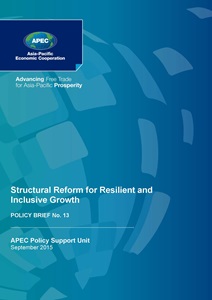Structural Reform for Resilient and Inclusive Growth

| Published Date | August 2015 |
|---|---|
| Type of Publication | Reports |
| Publication Under | APEC Secretariat, APEC Policy Support Unit |
| Accessed | 13096 |
| Pages | 12 |
| Download publication | Download |
Description
This policy brief examines the questions of what drives GDP growth and what should be done to achieve resilient and inclusive growth in the APEC region.
Based on the data, trade growth doesn’t seem to be the driver of GDP growth that it used to be. The slowdown in the responsiveness of GDP growth to trade is not cyclical but structural. An analysis of GDP growth elasticity with respect to trade and internal sources of demand shows that the reduction in trade elasticity is a process that has been going on over 15 years. On the other hand, the responsiveness of GDP growth to private consumption increased markedly after the Global Financial Crisis in 2008, implying that household demand—rather than trade or government spending—is the main driver of growth in the APEC region in recent years. Based on this finding, it seems that future APEC growth lies in strengthening household consumption through structural reform. Numerous studies show that structural reforms not only contribute to raising productivity, they also help make growth more inclusive. APEC has shown progress in its structural reform agenda, and is implementing several initiatives in the pursuit of resilient and inclusive growth.
Based on the data, trade growth doesn’t seem to be the driver of GDP growth that it used to be. The slowdown in the responsiveness of GDP growth to trade is not cyclical but structural. An analysis of GDP growth elasticity with respect to trade and internal sources of demand shows that the reduction in trade elasticity is a process that has been going on over 15 years. On the other hand, the responsiveness of GDP growth to private consumption increased markedly after the Global Financial Crisis in 2008, implying that household demand—rather than trade or government spending—is the main driver of growth in the APEC region in recent years. Based on this finding, it seems that future APEC growth lies in strengthening household consumption through structural reform. Numerous studies show that structural reforms not only contribute to raising productivity, they also help make growth more inclusive. APEC has shown progress in its structural reform agenda, and is implementing several initiatives in the pursuit of resilient and inclusive growth.

